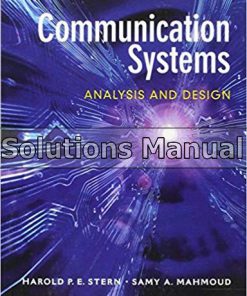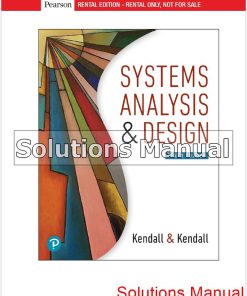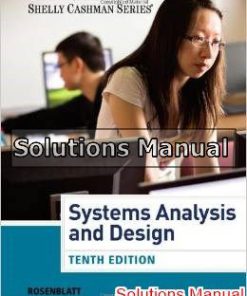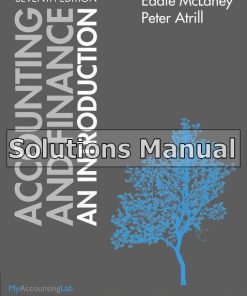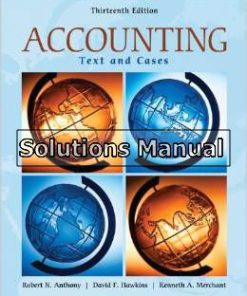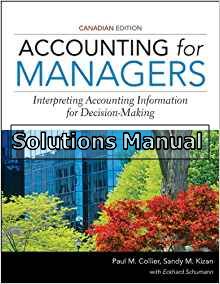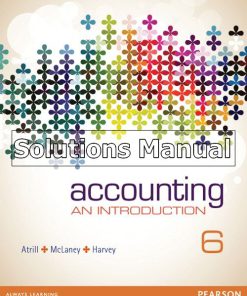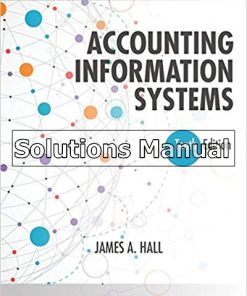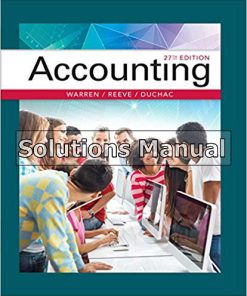Systems Analysis and Design 8th Edition Kendall Solutions Manual
$26.50$50.00 (-47%)
Systems Analysis and Design 8th Edition Kendall Solutions Manual.
You may also like
Systems Analysis and Design 8th Edition Kendall Solutions Manual
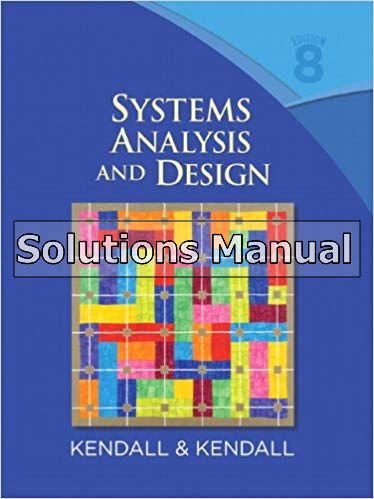
Product details:
- ISBN-10 : 013608916X
- ISBN-13 : 978-0136089162
- Author: Kendall & Kendall
Kendall and Kendall’s Systems Analysis and Design, 8e, is a human-centered book that concisely presents the latest systems development methods, tools, and techniques to readers in an engaging and easy-to-understand manner. The eighth edition highlights the latest advancements in the rapidly changing Information Systems field.
Table contents:
Part 1 Planning Phase
1 The Systems Analyst and Information Systems
Development, 3
Introduction, 4
The Systems Analyst, 6
Systems Analyst Skills, 6
Systems Analyst Roles, 7
The Systems Development Life Cycle, 8
Planning, 10
Analysis, 11
Design, 12
Implementation, 12
Project Identification and Initiation, 13
System Request, 15
Applying the Concepts at DrōnTeq, 16
Feasibility Analysis, 19
Technical Feasibility, 20
Economic Feasibility, 21
Organizational Feasibility, 27
Applying the Concepts at DrōnTeq, 29
Chapter Review, 31
Appendix 1A: Detailed Economic Feasibility
Analysis for DrōnTeq, 35
2 Project Selection and Management, 37
Introduction, 38
Project Selection, 39
Applying the Concepts at DrōnTeq, 40
Creating the Project Plan, 41
Project Methodology Options, 42
Selecting the Appropriate Development Methodology, 49
Contents
Dennis8e_ftoc.indd 11 6/30/2021 9:16:30 AM
xii Contents
Staffing the Project, 52
Staffing Plan, 52
Coordinating Project Activities, 55
Managing and Controlling the Project, 58
Refining Estimates, 58
Managing Scope, 60
Timeboxing, 60
Managing Risk, 61
Applying the Concepts at DrōnTeq, 62
Staffing the Project, 63
Coordinating Project Activities, 64
Chapter Review, 65
Part 2 Analysis Phase
3 Requirements Determination, 71
Introduction, 72
The Analysis Phase, 72
Requirements Determination, 74
What Is a Requirement?, 74
The Process of Determining Requirements, 78
The Requirements Definition Statement, 78
Requirements Elicitation Techniques, 80
Requirements Elicitation in Practice, 80
Interviews, 81
Joint Application Development (JAD), 88
Questionnaires, 92
Document Analysis, 94
Observation, 96
Selecting the Appropriate Techniques, 96
Requirements Analysis Strategies, 98
Problem Analysis, 98
Root Cause Analysis, 98
Duration Analysis, 100
Activity-Based
Costing, 100
Informal Benchmarking, 100
Outcome Analysis, 101
Technology Analysis, 101
Activity Elimination, 102
Comparing Analysis Strategies, 103
Applying the Concepts at DrōnTeq, 103
Eliciting and Analyzing Requirements, 103
Requirements Definition, 104
System Proposal, 104
Chapter Review, 106
Dennis8e_ftoc.indd 12 6/30/2021 9:16:30 AM
Contents xiii
4 Understanding Processes with Use Cases and Process
Models, 111
Introduction, 112
What Is a Use Case?, 113
The Use Case Concept in a Nutshell, 113
Use Case Formats and Elements, 114
Casual Use Case Format, 114
Use Cases in Sequence, 117
Applying Use Cases, 118
Use Case Practical Tips, 118
Use Cases and Functional Requirements, 119
Use Cases and Testing, 119
Creating Use Cases, 120
Identify the Major Use Cases, 120
Identify the Major Steps for Each Use Case, 122
Identify Elements within Steps, 125
Confirm the Use Case, 128
Revise Functional Requirements Based on Use Cases, 129
Applying the Concepts at DrōnTeq, 129
Identifying the Major Use Cases, 129
Elaborating on the Use Cases, 130
Data Flow Diagrams, 134
Reading Data Flow Diagrams, 134
Elements of Data Flow Diagrams, 136
Using Data Flow Diagrams to Define Business Processes, 139
Process Descriptions, 142
Creating Data Flow Diagrams, 144
Creating the Context Diagram, 145
Creating Data Flow Diagram Fragments, 146
Creating the Level 0 Data Flow Diagram, 148
Creating Level 1 Data Flow Diagrams (and Below), 149
Validating the Data Flow Diagrams, 152
Applying the Concepts at DrōnTeq, 156
Developing the Process Model, 156
Creating Data Flow Diagram Fragments, 156
Creating the Level 1 Data Flow Diagram, 157
Creating Level 2 Data Flow Diagrams (and Below), 159
Validating the Data Flow Diagrams, 160
Chapter Review, 161
5 Data Modeling, 169
Introduction, 170
The Entity Relationship Diagram, 170
Reading an Entity Relationship Diagram, 171
Elements of an Entity Relationship Diagram, 172
The Data Dictionary and Metadata, 177
Dennis8e_ftoc.indd 13 6/30/2021 9:16:30 AM
xiv Contents
Creating an Entity Relationship Diagram, 179
Building Entity Relationship Diagrams, 179
Advanced Syntax, 182
Applying the Concepts at DrōnTeq, 184
Validating an Entity Relationship Diagram, 188
Design Guidelines, 188
Normalization, 191
Balancing Entity Relationship Diagrams with Data Flow Diagrams, 191
Chapter Review, 193
Appendix 5A: Normalizing The Data Model, 196
6 Moving into Design, 201
Introduction, 202
Transition from Requirements to Design, 202
System Acquisition Strategies, 204
Custom Development, 206
Packaged Software, 207
Outsourcing, 208
Influences on the Acquisition Strategy, 211
Business Need, 211
In-House
Experience, 212
Project Skills, 213
Project Management, 213
Time Frame, 213
Selecting an Acquisition Strategy, 213
Alternative Matrix, 214
Applying the Concepts at DrōnTeq, 216
Chapter Review, 218
Part 3 Design Phase
7 Architecture Design, 223
Introduction, 224
Elements of an Architecture Design, 224
Architectural Components, 224
Client–Server Architectures, 225
Client–Server Tiers, 226
Server-Based
Architecture, 228
Mobile Application Architecture, 229
Advances in Architecture Configurations, 230
Comparing Architecture Options, 231
Creating an Architecture Design, 232
Operational Requirements, 232
Performance Requirements, 233
Security Requirements, 235
Dennis8e_ftoc.indd 14 6/30/2021 9:16:31 AM
Contents xv
Access Control Requirements, 237
Cultural and Political Requirements, 240
Designing the Architecture, 242
Hardware and Software Specification, 244
Applying the Concepts at DrōnTeq, 246
Creating an Architecture Design, 246
Hardware and Software Specification, 247
Chapter Review, 248
8 User Interface Design, 251
Introduction, 252
The Usability Concept, 252
Principles for User Interface Design, 253
Layout, 253
Content Awareness, 255
Aesthetics, 256
Usage Level, 256
Consistency, 258
Minimize User Effort, 259
Special Issues of Touch Screen Interface Design, 259
User Interface Design Process, 260
Understand the Users, 261
Organize the Interface, 263
Define Standards, 266
Interface Design Prototyping, 267
Interface Evaluation/Testing, 269
Navigation Design, 273
Basic Principles, 273
Menu Tips, 274
Message Tips, 276
Input Design, 279
Basic Principles, 279
Input Tips, 281
Input Validation, 283
Output Design, 283
Basic Principles, 283
Types of Outputs, 285
Media, 287
Applying the Concepts at DrōnTeq, 288
Understand the Users, 288
Organize the Interface, 289
Define Standards, 290
Interface Template Design, 290
Develop Prototypes, 295
Interface Evaluation/Testing, 296
Chapter Review, 296
Dennis8e_ftoc.indd 15 6/30/2021 9:16:31 AM
xvi Contents
9 Program Design, 301
Introduction, 302
Moving from Logical to Physical Process Models, 302
The Physical Data Flow Diagram, 302
Applying the Concepts at DrōnTeq, 305
Designing Programs, 306
Structure Chart, 309
Syntax, 310
Building the Structure Chart, 313
Applying the Concepts at DrōnTeq, 315
Design Guidelines, 319
Program Specification, 325
Syntax, 325
Applying the Concepts at DrōnTeq, 328
Chapter Review, 331
10 Data Storage Design, 337
Introduction, 338
Data Storage Formats, 338
Files, 339
Databases, 341
Selecting a Storage Format, 345
Applying the Concepts at DrōnTeq, 347
Moving from Logical to Physical Data Models, 348
The Physical Entity Relationship Diagram, 348
Revisiting the CRUD Matrix, 351
Applying the Concepts at DrōnTeq, 352
Optimizing Data Storage, 352
Optimizing Storage Efficiency, 355
Optimizing Access Speed, 357
Estimating Storage Size, 361
Applying the Concepts at DrōnTeq, 363
Chapter Review, 365
11 Moving into Implementation, 368
Introduction, 368
Managing the Programming Process, 369
Assigning Programming Tasks, 369
Coordinating Activities, 370
Managing the Schedule, 371
Testing, 371
Test Planning, 373
Unit Tests, 373
Integration Tests, 376
Dennis8e_ftoc.indd 16 6/30/2021 9:16:31 AM
Contents xvii
System Tests, 376
Acceptance Tests, 376
Developing Documentation, 378
Types of Documentation, 379
Designing Documentation Structure, 379
Writing Documentation Topics, 381
Identifying Navigation Terms, 382
Applying the Concepts at DrōnTeq, 384
Managing Programming, 384
Testing, 384
Developing User Documentation, 385
Chapter Review, 388
Part 4 Implementation Phase
12 Transition to the New System, 393
Introduction, 393
Making the Transition to the New System, 394
The Migration Plan, 395
Selecting the Conversion Strategy, 396
Preparing a Business Contingency Plan, 400
Preparing the Technology, 401
Preparing People for the New System, 402
Understanding Resistance to Change, 402
Revising Management Policies, 404
Assessing Costs and Benefits, 404
Motivating Adoption, 407
Enabling Adoption: Training, 408
Postimplementation Activities, 411
System Support, 411
System Maintenance, 412
Project Assessment, 414
Applying the Concepts at DrōnTeq, 416
Implementation Process, 416
Preparing the People, 416
Postimplementation Activities, 416
Chapter Review, 417
13 Agile Development Methods, 420
Introduction, 420
Origins of Agile, 421
Evolution of Agile Development, 422
Adoption of the Agile Approach, 423
Benefits of Agile Methods, 423
Adoption of Specific Agile Methodologies, 423
Dennis8e_ftoc.indd 17 6/30/2021 9:16:31 AM
xviii Contents
Scrum, 424
Overview of Scrum, 424
Scrum Characteristics, 426
Scrum Roles, 426
Scrum Features, 428
Scrum Processes, 432
How Does Scrum End?, 436
Other Types of Agile Methodologies, 436
Crystal Development Methodology, 436
Dynamic Systems Development Methodology, 437
Feature Driven Development, 437
Lean Software Development, 438
Comparing the SDLC with Agile Methodologies, 438
Chapter Review, 439
Index I-1
People also search:
systems analysis and design 8th edition
systems analysis and design 8th edition dennis wixom and roth
systems analysis and design 8th edition dennis wixom roth wiley
|
systems analysis and design in a changing world 8th edition
|
business systems analysis and design



